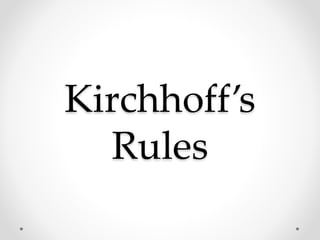
Kirchhoff’s rules
- 2. Objectives • For us to know what are the kirchhoff’s rules and how to compute currents using it. • To be familiar with the formulas and different concepts.
- 3. Features • Kirchhoff's rules provide a means of obtaining enough independent equations to solve for the currents flowing in an electrical circuit. • Kirchhoff's circuit laws are two equalities that deal with the current and potential difference in the lumped element model of electrical circuits. • They were first described in 1845 by German physicist Gustav Kirchhoff.
- 4. Definition of Terms • Junction- a point where three or more conductors meet. • Electromotive force- is the voltage developed by any source of electrical energy such as a battery or dynamo.[ • Law of Conservation of Charge- current is flow of charge per time, and if current is constant, that which flows into a point in a circuit must equal that which flows out of it. • Law of Conservation of Energy- the total energy gained per unit charge must equal the amount of energy lost per unit of charge.
- 5. Kirchhoff’s Rules • Junction/Voltage Rule-this is based on the conservation of charge: the sum of currents entering a junction is equal the sum leaving. Formula: i2 + i3 = i1 + i4 • Loop/Current Rule-this is based on the conservation of energy: The sum of voltages around a closed conducting loop must be zero. Formula: v1 + v2 + v3 + v4 = 0
- 7. Junction Rule: I0=I1+I2 I0= (-0.0375)+(0.015) I0= -0.0225 A Solution: Loop Rule: A: -I2(100Ω)+1.5=0 -100I2+1.5=0 I2=0.015 A B: -9v-I1(200Ω)+I2(100Ω)=0 -9-200I1+(0.015)(100)=0 -200I1=7.5 I1= -0.0375 A
- 8. Applications
- 9. Objectives • To know how the rules could be applied and could contribute to our everyday lives and to the society. • For us to understand the Kirchhoff’s rules in a wider perspective.
- 10. New Developments • With China's economic rapid development and expansion of urban areas, urban traffic congestion is becoming increasingly obvious, following from that is not optimistic, the coming of the scarcity of urban road resources and traffic situation. At the present time, the simulation model on domestic and foreign does not really reflect that the traffic flow from the emergence and development of the life-cycle process to reduce traffic flow. Kirchhoff's law for the basic theory of the analysis, identify the relationship between the resistances of traffic and the traffic flow, traffic volume, and so on, to obtained analysis model, and reveal the law of the traffic flow life-cycle. ADVANTAGES: • It could really help to reduce traffic by just applying the concept of Kirchhoff’s rules. DISADVANTAGES: • There could still be limitations because flows in electric currents are spontaneous and the flows in traffics are sometimes unpredictable.
- 11. Implication to Science and Technology • A matrix version of Kirchhoff's current law is the basis of most circuit simulation software, such as SPICE. It is a powerful program that is used in integrated circuit and board-level design to check the integrity of circuit designs and to predict circuit behavior. • Kirchhoff's current law combined with Ohm's Law is used in nodal analysis, a method of determining the voltage (potential difference) between "nodes. • Kirchhoff's rules can be used to analyze any circuit and modified for those with EMFs, resistors, capacitors and more.
- 13. Objective For us, to learn about single-loop circuits and how it help us in our everyday lives.
- 14. Definition of Terms • Electrical Circuit- is a network consisting of a closed loop, giving a return path for the current • Direct current (DC)- is the unidirectional flow of electric charge
- 16. Application Without circuits, electricity could be impossible, and without electricity, we will suffer. Especially these modern days.
